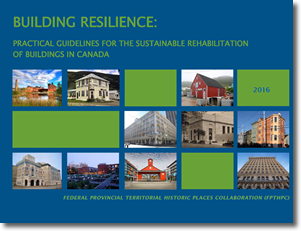Building Resilience: Practical Guidelines for the Sustainable Rehabilitation of Buildings in Canada
Building Resilience: Practical Guidelines for the Sustainable Rehabilitation of Buildings in Canada (PDF), is a new publication produced through the Federal/Provincial/Territorial Collaboration on Historic Places in Canada, which promotes how the conservation of heritage buildings can contribute to energy efficiency, sustainable development and achieving provincial environmental policy initiatives.
Building Resilience is a pan-Canadian “how-to” approach for practitioners, design professionals, building owners and officials responsible for built heritage at all jurisdictional levels.
It is a document that:
- offers a useful set of best practices, tools, guidelines and case studies on the adaptive re-use or retrofitting of heritage buildings to improve their environmental performance;
- addresses perceptions that heritage buildings are inefficient from an energy consumption perspective;
- presents experiences with heritage buildings as models for maintaining and retrofitting existing building stock generally; and
- informs and educates other sectors (e.g., development / real estate) on the environmental benefits of building conservation (as compared to erecting new buildings).
Building Resilience is a standalone document, but it can also complement and supplement the Standards and Guidelines for the Conservation of Historic Places in Canada.



